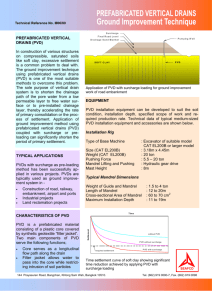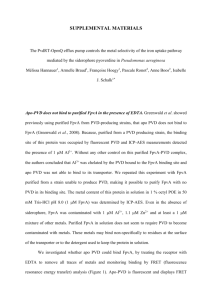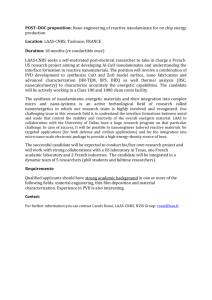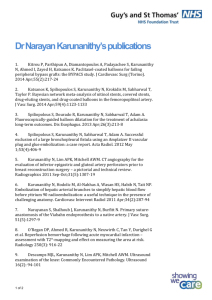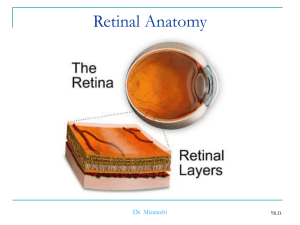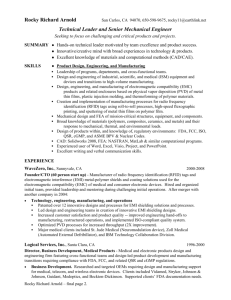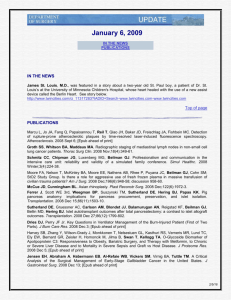(acronym) Trial - Clinical Trial Results
advertisement
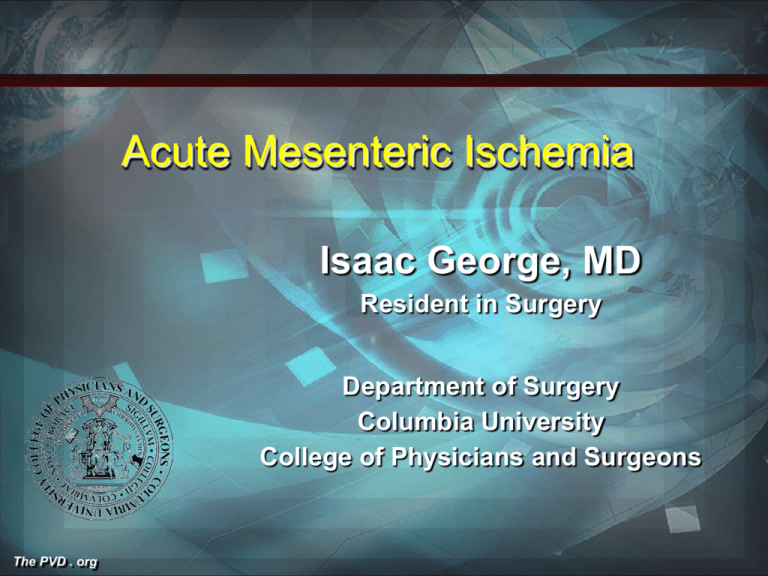
Acute Mesenteric Ischemia Isaac George, MD Resident in Surgery Department of Surgery Columbia University College of Physicians and Surgeons The PVD . org Acute Mesenteric Ischemia • • • • • • Incidence Pathophysiology Diagnosis Therapy Treatment Algorithm Objectives The PVD . org Objectives • • • Understand pathophysiology Identify patients at high-risk for mesenteric ischemia Develop treatment plan for each patient/apply treatment algorithm The PVD . org Introduction • Cokkinis (1921): “occlusion of the mesenteric vessels is regarded as one of those conditions of which the diagnosis is impossible, the prognosis hopeless, and the treatment almost useless.” • Occlusive or non-occlusive mechanism leading to hypoperfusion of one or more mesenteric vessels The PVD . org Rationale • Incidence – – • 1-2/1000 hospital admissions 1% of GI admissions1 Mortality – – • 1960’s - 70-100%2 1970’s - 60-70%3 Morbidity – – • Cardiopulmonary, MOSF Extended LOS, TPN dependence4 Recurrence – The PVD . org Up to 60%4 1 Ann Surg 2001;233(6):801-808 Ann Surg 1982;195:554-565 3 Ann Surg 1978;188;721-731 4 Ann Vasc Surg 2003;17:72-9 2 Anatomic Considerations The PVD . org Pathophysiology: Etiology • Arterial Embolic Disease • Arterial Thrombotic Disease • Venous Thrombotic Disease • Non-occlusive Mesenteric Ischemia The PVD . org Pathophysiology Arterial Embolism • • • • • • Majority of cases (>50%): SMA occlusion Location: origin of middle colic artery (ischemia from proximal jejunem to splenic flexure) Embolic sources: cardiac (80%)1, aortic plaques Celiac and IMA occlusion usually tolerated SMA occlusion → death Most have underlying stenoses as well 1 The PVD . org Ann Vasc Surg 1990;4:112-116 Pathophysiology Arterial Thrombotic Disease 15% of acute intestinal ischemia1 Pre-existing atherosclerotic disease ― Worsening chronic mesenteric ischemia • Found at ostium of SMA • More delayed onset of symptoms • • 1 The PVD . org Vasc Surg 1996; 4th ed. Pathophysiology Venous Thrombotic disease • • • • • The PVD . org 5-10% of intestinal ischemia Younger patient population 80% have hypercoaguable state Risk factors: oral contraceptives, previous DVT/PE, malignancy, portal HTN, nephrotic syndrome May limit arterial flow→edema, segmental infarction Pathophysiology Non-Occlusive disease • • 20-30% of acute intestinal ischemia Response to systemic hypoperfusion ― Sympathetic adrenergic system mediated • • Visceral vasoconstriction/shunting for cerebral protection Causes: any severe systemic illness, CHF, dehydration, drugs (cocaine, ergot alkaloids, digitalis, β-blockers, α-agonist, epo), hemodialysis The PVD . org Clinical Presentation: Physical Examination Arterial Thromboembolic, Non-Occlusive • Severe abdominal pain • Sudden onset Venous Thrombotic • Less severe pain • Subacute • Symptoms variable • Abdominal pain-non-specific, crampy vs. steady, anterior • Gastric emptying/vomiting • Peritonitis late • Hypotension, tachycardia The PVD . org Clinical Presentation: Laboratory Limited clinical utility • arterial lactate1 • amylase2 • CK, CK-BB3 • Serum phosphate4 • Other useless markers: LDH, PAF, TNF-α, AP, AST/ALT, αglutathione The PVD . org 1 Eur J Surg 1994;160:381-4 2 Br J Surg 1986;73:219-21 3 Dig Dis Sci 1991;36:1589-93 4 Br J Surg 1982;69:S52-3 Clinical Presentation: Risk Factors J Vasc Surg 2002;35:445-52 The PVD . org Clinical Presentation: Risk factors Ann Surg 2001;233(6):801-808 The PVD . org Clinical Presentation: Risk factors Ann Surg 2001;233(6):801-808 The PVD . org Clinical Presentation Ann Vasc Surg 2003;17:72-79 The PVD . org Clinical Presentation Ann Surg 2001;233(6):801-808 The PVD . org Diagnosis: Non-Invasive Imaging X-ray Computed Tomography (helical/angiography) Ultrasound MRI/MRA The PVD . org Diagnosis: X-Ray Plain Films • • pneumatosis portal venous gas • thumbprinting → • Findings late, associated with high mortality The PVD . org Diagnosis: Computed Tomography Criteria • pneumatosis • venous gas • SMA/celiac/IMA occlusion w/distal disease • arterial embolism Sensitivity: 96% Specificity: 94% OR • bowel wall thickening + one of following: – – – lack of bowel wall enhancement solid organ infarction venous thrombosis 1 The PVD . org Radiol 2003;229:91-98 Computed Tomography Radiol 2003;229:91-98 The PVD . org Computed Tomography The PVD . org Radiol 2003;229:91-98 Computed Tomography Radiol 2003;229:91-98 The PVD . org Volume Rendering: Normal RG 2002;22:161-172 The PVD . org Volume Rendering: Ischemia RG 2002;22:161-172 The PVD . org Diagnosis: Ultrasound High-grade stenosis or occlusion of SMA • Sensitivity for SMA stenosis: 96% (1993) 1 – – • Prospective, n=100 Surgically confirmed embolism/thrombus Sensitivity for SMA stenosis/occlusion: 100% (1999)2 – – – – The PVD . org Specificity: 98% PPV: 93%, NPV: 100% N=82, prospective Confirmed with angiography 1 J Vasc Surg 1993;17:780-788 2 Radiol 1999;211:405-410 Diagnosis: MRI • • • Poor delineation of smaller vessels Limited clinical application Perfusion flow contrast studies show promise1 1 The PVD . org Radiol 2004;234:569-575 Diagnosis: Angiography • 1 Gold Standard – Anatomic delineation of occlusion and collaterals – Plan operative revascularization – Allow infusion of therapeutic agents (lytics, vasodilators) Ann Surg 2001;233(6):801-808 The PVD . org Principles of Treatment • Diagnose • Restore Flow • Resect non-viable tissue • Supportive Care • Second-Look The PVD . org Therapy Supportive measures • IV resuscitation • Optimize cardiac status • Broad-spectrum antibiotics (no data) • Nasogastric decompression The PVD . org Therapy: Pharmacologic Anticoagulation • Heparin IV – – – Prevents clot propagation Systemic vs. intra-arterial Timing of initiation • – • Immediately vs. 48 hr delay1,2 Restart 48 hrs after surgical intervention Warfarin – – The PVD . org Prevents clot propagation Give for 6-12 mos if no clotting disorder (no data) 1 Surg Gynecol Obstet 1981;153:561-569 2 Vascular Emergencies. 1982;553-561 Therapy: Pharmacologic Vasodilators • Papaverine (30-60 mg/hr) – Increases cAMP, relaxes smooth muscle – Primary indication: Non-occlusive arterial disease – Criterion for use: • • • The PVD . org Peritoneal signs absent Cannot undergo surgery Must have good distal perfusion bed Therapy: Pharmacologic Vasodilators (cont.) • Papaverine – Early SMA infusion reduces mortality to 40-50%1 – Directed infusion via angiography – Rx: 24-48 hrs • • Endpoints both clinical and angiographic Subsequent surgery 1 The PVD . org Surg 1977;82:848-855 Therapy: Pharmacologic Thrombolysis • urokinase>streptokinase, rtPA – – Short t½, easily reversed Dose: high vs. low • – The PVD . org 5,000 U/hr - 600,000 U/hr Direct SMA infusion vs. operative placement Am Surg 2004;70(7):600-604 Therapy: Pharmacologic Thrombolysis • Duration: minutes – 48 hrs1 – too long → risk of bowel necrosis – Treat to re-establish flow vs. complete dissolution – > 48 hrs • – Greater risk of bleeding Discontinue • • • Worsening abdominal symptoms without evidence of thrombolysis Bleeding No angiographic improvement 1 The PVD . org JVIR 2005;16:317-329 Pooled Data The PVD . org JVIR 2005;16:317-329 Outcomes • Technical success: 43/48 • Technical failure: 5/48 • Outcome most dependent on age of thrombus/embolus • Improvement of abd pain in 1st hour is a favorable prognostic sign • Technical success does not equal clinical success • Survival: 43/48 • Safety The PVD . org JVIR 2005;16:317-329 Therapy: Pharmacologic Thrombolysis • Criterion for use: – – – – • Embolic/thrombotic disease Poor operative candidates No contraindications to fibrinolytics No bowel infarction (no peritonitis/acidosis) Expansion of use to all patients without bowel infarction The PVD . org Therapy: Endovascular Angioplasty/Stenting • • • Long-term durability questioned vs. surgical repair Utility in acute ischemia setting Advantages: – – Shorter duration of treatment than thrombolysis Definitive treatment JVIR 1999;10(7):861-867 The PVD . org Therapy: Endovascular Angioplasty/Stenting • Ideal for thrombotic lesions – – – • Calcified ostial lesions Flow-limiting dissections Chronic occlusion Advanced techniques for embolic lesions – – The PVD . org Flow-limiting dissections Embolectomy w/distal protection Therapy: Endovascular J Vasc Surg 2003;38:692-8 The PVD . org Therapy: Endovascular Stenting Outcomes (Chronic, SMA/Celiac) 1998: Primary patency 100% at 14 mos (n=3)1 0% mortality 1999: Primary patency 74% at 18 mos (n=12)2 8.3% mortality <30 days 2003: Technical success 96% (n=26)3 Clinical success 88% Primary patency at 34 mos 65% Restenosis at 34 mos 12% 1 The PVD . org Cardiovasc Int Radiol 1998;21:305-313 2 JVIR 1999;10(7):861-867 3 J Vasc Surg 2003;38:692-8I Therapy: Endovascular Stenting Indications • • • Simple stenotic lesions Complex lesions (long-segment, irregular, heavily calcified) Total occlusion Contraindications • • • Suspected bowel necrosis (peritonitis, acidosis, etc) diffuse distal disease Median arcuate ligament compression syndrome 1 The PVD . org J Vasc Surg 2003;38(4):692-8 Surgery Anyone with peritonitis needs to be explored. • • • • • • Midline incision Evaluate extent of ischemia Doppler of entire SMA Revascularization (embolectomy vs. bypass) Re-evaluate ischemia Lastly, non-viable bowel must be resected The PVD . org Surgery: Options for Revascularization Ann Vasc Surg 2003;17:72-79 The PVD . org Surgery: Principles If embolus suspected, transverse arteriotomy proximal to middle colic takeoff • • Embolectomy • Allow reperfusion for 20-30 minutes and then re-assess bowel viability Curr Opin Cardiol 1999;14(5):453-460 The PVD . org Surgery: Options for Revascularization • Thrombosis requires a bypass • Longitudinal arteriotomy • Thrombectomy • Inflow adequate: • Inflow inadequate: – Bypass • The PVD . org Vein vs. graft Curr Opin Cardiol 1999;14(5):453-460 Surgery: Options for Revascularization The PVD . org Curr Opin Cardiol 1999;14(5):453-460 Surgery: Damage Control 24-hr second look operation • Ischemia continues after acute event and reperfusion • No way to determine viability initially • Allows time for supportive measures to recover tissue The PVD . org Surgery: Options Case Reports • Angiography + Laparoscopy The PVD . org Outcomes After Surgery 20011 30 day mortality Embolic Thrombotic 59% 62% 20022 30 day mortality 1 year mortality 3 year mortality 32% 57% 68% 20033 Peri-op mortality 62% 20034 Peri-op mortality 15% 20055 Peri-op mortality 35% 1 Ann Surg 2001;233(6):801-808 J Vasc Surg 2002;35:445-52 3 Ann Vasc Surg 2003;17:72-79 4 Vasc Endovasc Surg 2003;37:245-252 5 W J Surg 2005;29:645-648 2 The PVD . org Outcomes After Surgery J Vasc Surg 2002;35:445-52 The PVD . org Outcomes After Surgery Ann Vasc Surg 2003;17:72-79 The PVD . org Outcomes • TPN dependence: – • • • • 8-31%1,2 Significant morbidity No studies comparing stenting vs. open surgery No studies comparing embolectomy vs. bypass Early intervention most important factor for survival 1J 2 The PVD . org Vasc Surg 2002;35:445-52 Ann Surg 2001;233:801-808 Management of Mesenteric Vein Thrombosis • • • • • 5-10% of mesenteric ischemia Subacute vs. chronic Better prognosis Diagnosis: CT scanning, venography Therapy: anticoagulation, thrombolysis – • • • surgery if bowel compromise suspected No role for venous thrombectomy Long-term anticoagulation Hypercoaguable workup 1 JVIR 2 The PVD . org 2005;16:317-329 Surg Lap Endo Perc Tech 2003;13(3):215-217 What Should You Do? Supportive • • • IV heparin Broad-spectrum antibiotics Hemodynamic optimization ― Volume status ― Cardiac function The PVD . org Supportive Measures AXR Other cause (perforated viscous) Peritonitis Yes Not sure?? No (? Laparoscopy) •Prompt laparotomy •Open bypass vs. Angiography ± Stenting ± Second look Suspect arterial occlusion Abdominal angiogram •Filling of SMA •Good collaterals Thrombolysis Anticoagulation The PVD . org CT Angio Arterial occlusion Venous occlusion •SMA occluded •No collaterals •Open bypass vs. Angiography ± Stenting Anticoagulation Anticoagulation

